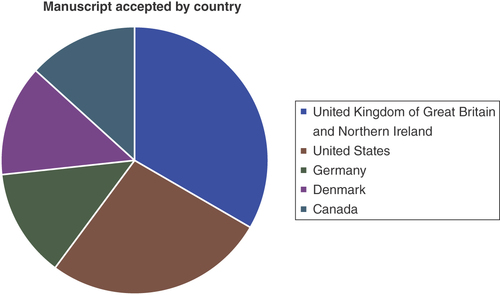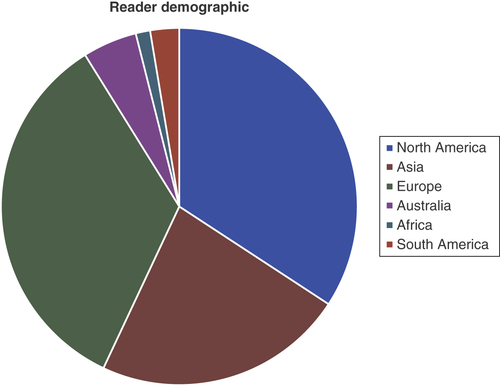What an eventful year it has been! We have seen novel research; reviews and an abundance of Plain Language Summary of Publications being published in the journal for the duration of 2023. Before we proceed with the new issue, let us look back at the highlights of our 13th volume.
During June of 2023, Neurodegenerative Disease Management received an impressive initial impact factor of 2.6. This was thrilling news, and we will dedicate time and effort to continuously publish high quality academic work to further boost this number.
2023’s most read & cited articles
Plain Language Summary of Publications were the readers’ favorite, as indicated by . The first place, however, goes to a review by M Amin & CM Hersh [Citation1]. Here, the authors provided up-to-date information of the neurotherapeutics available for multiple sclerosis as well as detailing the areas of prominent advances.
Table 1. The top five most read articles in Neurodegenerative Disease Management 2023.
As mentioned earlier, four out of the top five most read paper were Plain Language Summary of Publications (PLSPs). With the aim of simplifying science for non-experts to understand, PLSP’s have rapidly gained attraction. H Hampel et al.‘s PLSP on the amyloid-β pathway in Alzheimer’s disease was the second most read paper [Citation2]. Amyloid-β is strongly theorized to be implicit in Alzheimer’s disease, and this article provides a vast audience with access to the mechanism underlying the causation of the disease. This could help to educate the public.
The third most read article goes to a PLSP detailing the safety outcome from clinical studies on evobrutinib for multiple sclerosis (MS). A well-tolerated oral medication, this article provides readers with simplified, scientific, jargon-free information on potential side effects and limitations of the trial [Citation3].
The fourth most read article is titled: ‘A plain language summary of the impact of vaccines against flu and chickenpox in people with multiple sclerosis treated with cladribine tablets’ [Citation4]. The fifth most read article also focuses on MS and cladribine tablets [Citation5]; however, this PLSP details the effectiveness of the drug in comparison to others on the market.
The most cited articles, unlike the most read, varied, with a Systematic Review taking the top spot [Citation6]. lists all of the most cited articles, and it is evident that no particular neurodegenerative disease is more popular than the other, unlike what was seen with the most read articles where MS was clearly more popular among readers.
Table 2. The top five most cited articles in Neurodegenerative Disease Management 2023.
Online engagement
Almetric scores are used to quantify the social media engagement that an article receives. This is an initial indicator of the impact a published article has. lists the articles with the top 5 highest scores and like those in the most-read table, the article type with the most impact are PLSPs. Only one of the top 5 is a Research Article [Citation7], and this was also the second most cited article.
Table 3. The top five articles with the most social media engagement in Neurodegenerative Disease Management 2023.
Authorship & readership demographics
The authorship demographic for Neurodegenerative Disease Management centers mostly within European and North American countries. This is unsurprising, as these disease types are more prevalent within these regions. The UK and USA took the first and second spots, with 25 and 20% of all papers accepted coming from these two nations, respectively ().
As a reflection of the author demographic, reader demographics also showed that Europe and North America are continents with the most abundant readers with 34% each; thus, together they make up 68% of the total readers ().
What’s in store for 2024?
This year Neurodegenerative Disease Management has reached a milestone by gaining an impact factor! As mentioned throughout, PLSPs are taking over, and we are eager to see what 2024 will bring. We strive to grow and publish the most novel scientific research in the neuroscientific field with regards to disease management.
If you would like to submit unsolicited articles such as a PLSP, original research, Systematic Review, Editorials and so on, please do reach out or find the author guidelines for submissions on our website.
Lastly, the editorial team of Neurodegenerative Disease Management would like to thank our valued authors, readers and Editorial Board members.
Financial disclosure
The author has no financial involvement with any organization or entity with a financial interest in or financial conflict with the subject matter or materials discussed in the manuscript. This includes employment, consultancies, honoraria, stock ownership or options, expert testimony, grants or patents received or pending, or royalties.
Competing interests disclosure
A Paleel is an employee of Taylor and Francis. The author has no other competing interests or relevant affiliations with any organization or entity with the subject matter or materials discussed in the manuscript. This includes employment, consultancies, stock ownership or options and expert testimony.
Writing disclosure
No writing assistance was utilized in the production of this manuscript.
References
- Amin M, Hersh CM. Updates and advances in multiple sclerosis neurotherapeutics. Neurodegener. Dis. Manag. 13(1), 47–70 (2023).
- Hampel H, Hu Y, Hardy J et al. The amyloid-β pathway in Alzheimer’s disease: a plain language summary. Neurodegener. Dis. Manag. 13(3), 141–149 (2023).
- Montalban X, Wallace D, Genovese MC. A plain language summary of what clinical studies can tell us about the safety of evobrutinib – a potential treatment for multiple sclerosis. Neurodegener. Dis. Manag. 13(4), 207–213 (2023).
- Schmierer K, Wiendl H, Oreja-Guevara C et al. A plain language summary of the impact of vaccines against flu and chickenpox in people with multiple sclerosis treated with cladribine tablets. Neurodegener. Dis. Manag. 13(1), 15–21 (2023).
- Spelman T, Ozakbas S, Alroughani R et al. A plain language summary on the effectiveness of cladribine tablets compared with other oral treatments for multiple sclerosis: results from the MSBase registry. Neurodegener. Dis. Manag. 13(4), 215–221 (2023).
- Harrison EC, Earhart GM. The effect of auditory cues on gait variability in people with Parkinson’s disease and older adults: a systematic review. Neurodegener. Dis. Manag. 13(2), 113–128 (2023).
- Anwar MM, Fathi MH. Early approaches of YKL-40 as a biomarker and therapeutic target for Parkinson’s disease. Neurodegener. Dis. Manag. 13(2), 85–99 (2023).
- Vaughn CB, Kavak KS, Jakimovski D et al. Patient-reported outcomes are the strongest predictors of disease disability in intramuscular interferon β-1a users. Neurodegener. Dis. Manag. 13(3), 151–159 (2023).
- Shih H-JS, Quinn L, Morgan-Jones P et al. Wearable activity monitors to support physical activity interventions in neurodegenerative disease: a feasibility study. Neurodegener. Dis. Manag. 13(3), 177–189 (2023).
- Montalban X, Wallace D, Genovese MC et al. A plain language summary of what clinical studies can tell us about the safety of evobrutinib – a potential treatment for multiple sclerosis. Neurodegener. Dis. Manag. 13(4), 207–213 (2023).
- Giovannoni G, Boyko A, Correale J et al. A plain language summary on assessing the long-term effectiveness of cladribine tablets in people living with relapsing multiple sclerosis: the CLASSIC-MS study. Neurodegener. Dis. Manag. 13(5), 261–268 (2023).
- Braeckman R, Oh C. A study of once-a-week donepezil transdermal system’s bioequivalence to oral donepezil in healthy volunteers: a plain language summary. Neurodegener. Dis. Manag. 13(6), 303–313 (2023).



